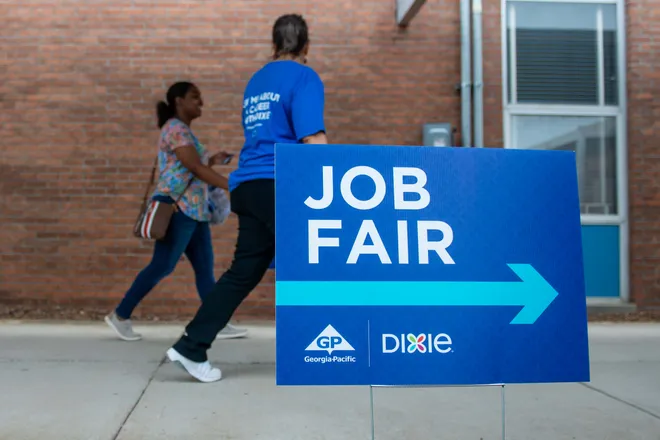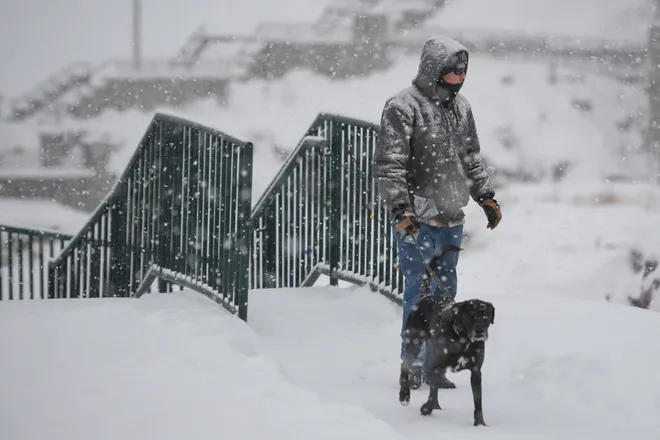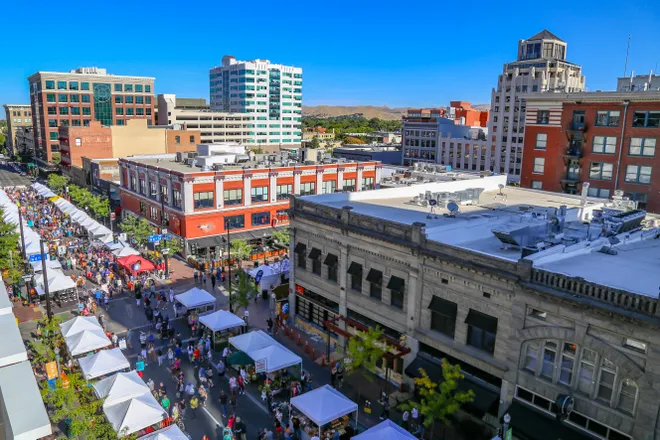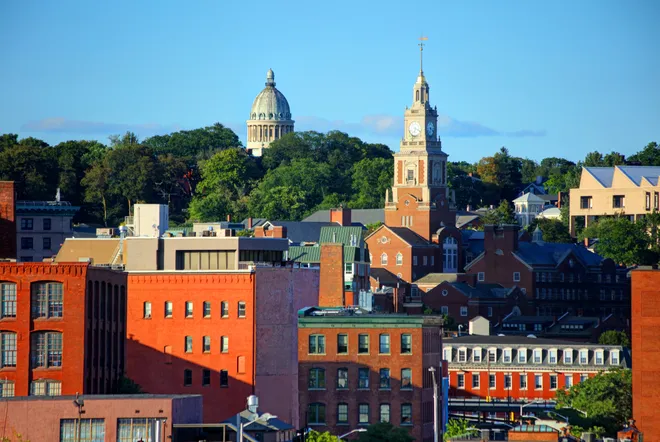The 5 states with the fastest job growth in 2023, and the 5 states with the slowest gains
The U.S. turned in another surprisingly strong year of job growth in 2023, defying forecasts of a sharp slowdown amid historically high interest rates and still elevated inflation.
But some states, such as Nevada and Texas, powered the gains while others, like Rhode Island and Iowa, barely treaded water. States with favorable climates, low costs and vibrant business hubs continued to attract residents and create jobs. Those losing population and stressed by high borrowing costs struggled.
Overall, the nation added 3.1 million jobs last year, or an average of 255,000 a month. That's the third-best showing ever behind 2021 and 2022 when the U.S. was climbing out of the pandemic-induced recession.
Why?
Consumer spending remained robust despite the higher costs, notes Julia Pollak, chief economist of ZipRecruiter, a leading job site. Give credit to sharp wage growth.
And the nation is still benefitting “a little bit” from a post-COVID rebound in hiring, says Adam Kamins, regional economist at Moody’s Analytics.
Industries such as restaurants and hotels finally reclaimed pre-COVID employment levels as many Americans idled by the pandemic returned to the labor force, joining a surge of immigrants.

But monthly job gains gradually slowed throughout 2023 and many economists expect a bigger pullback this year. Moody’s is forecasting an average of just 72,000 job gains a month.
States that fueled hiring last year could continue to do so, Pollak says, helping determine how much of a downshift the labor market faces in 2024. Fed rate cuts also will be key, she says. Lower borrowing costs encourage companies to invest.
Here are the five states with the fastest job growth last year and the five states with the slowest, based on their percentage rise in payrolls, according to a ZipRecruiter analysis of Labor Department data. Keep in mind that U.S. employment increased 2% last year, among its best showings in the last two decades.
Top performers:
Nevada

Employment gain: 3.8%
The state led the nation with the fastest job growth for the third straight year. After crashing during COVID, the casino and tourism industry that drives Nevada’s economy mounted a big comeback as the pandemic faded, Pollak says.
The tourism surge is no longer a rebound from the health crisis but rather a fresh spike as Americans flush with cash look to spend it, Kamins says. Business travel, however, did bounce back more strongly last year, Pollak and Kamins say, juicing hiring in Las Vegas, which hosted the Super Bowl on Sunday.
Also driving employment gains are new electric vehicle parts and battery factories in the Reno area, the economists say.
And the low-cost state, blessed with mild weather, is drawing a flood of new residents, including retirees, especially from nearby California. That’s boosting a wide range of industries, from professional and business services to health care. A growing labor force, in turn, is attracting companies.
But tourism is volatile and could soften if the economy slows or slips into a recession this year.
South Dakota

Employment gain: 3%
The agricultural state has struggled because of corn, soybean and other commodity prices that have fallen from their mid-2022 peaks. But cattle ranchers have benefitted from lower feed costs and higher beef prices, Moody’s says in a report. And the federal government continues to provide generous subsidies to farmers.
Meanwhile, South Dakota’s outsize banking industry is grappling with high interest rates that have dampened mortgages and other loans.
But there’s a big positive. With lots of land and low housing costs, the state is adding new residents, according to Moody’s, sparking feverish hiring in the construction industry. The state vaulted to No. 2 from 33rd in job growth in 2022.
Idaho

Employment gain: 3%
The state posted torrid growth during the pandemic as residents in large cities flocked to Boise, a burgeoning cultural center with affordable housing and lots of open space.
It’s still gaining residents but at a far slower clip now that the growth spurt has propelled housing prices higher, Kamins says.
The state’s tech industry has felt the effects of high interest rates, which discourage venture capital investment. But it’s still adding jobs, partly because of the construction of a new Micron chip factory, Moody’s says.
Wyoming

Employment gain: 2.8%
Oil and natural gas prices have dropped because of ample supplies, hurting the state’s mining industry. And the state is gaining residents, though just modestly.
But tourism is thriving due to an abundance of national parks, Moody’s says. And the clean energy provisions of the federal Inflation Reduction Act are driving the construction of several energy-related facilities that are goosing payrolls.
Texas

Employment gain: 2.7%
The state has been booming for years as it attracts both residents and companies, especially from California, because of its low costs and mild climate.
The oil and natural gas industries have coped with falling prices that discourage drilling, but hiring has stayed strong partly because of energy producers’ efforts to attract employees following dire labor shortages, Moody’s says. Also, the firm says, European demand for liquefied natural gas is expected to increase as the continent seeks alternative energy sources following Russia’s invasion of Ukraine.
Weakest performers
Rhode Island

Employment gain: 0.4%
The state continues to wrestle with a big tax burden, high costs, poor infrastructure and a stagnant population, Moody’s says.
Many residents commute to Boston for jobs, a set-up that was bolstered by the popularization of remote work since the pandemic. That curtails the number of available workers in Rhode Island. Although health care jobs are rising solidly, there aren’t enough local workers to fill openings and serve an aging population.
Vermont

Employment gain: 0.5%
Like Rhode Island, Vermont is beset by a stagnant population.
The state has a vibrant tourism industry but a dearth of snow hurt the ski season and a historically wet summer discouraged visitors as well, Moody’s says.
Meanwhile, a chip production factory, the state’s largest employer, has laid off workers because of low global demand. A new Defense Department contract should begin to spark hiring.
Iowa

Employment gain: 0.6%
Population growth has been weak in the farm-heavy state. And falling commodity prices have hurt corn and soybean farmers
Meanwhile, the state’s large finance and insurance industry has been hobbled by high interest rates that have curtailed borrowing, Kamins says. Budget strains also have discouraged consumers and businesses from buying expensive insurance plans, Moody’s says.
Mississippi

Employment gain: 0.7%
A declining population and labor shortages limit hiring in industries such as manufacturing and tourism, Moody’s says.
The state is also beset by low incomes and high poverty, Pollak says. Most industries shed jobs last year.
Tennessee

Employment gain: 0.7%
The state was a fourth-ranked jobs gainer in 2022. Americans moved to Nashville in droves before and during the pandemic, seeking a culturally dynamic, less densely populated city with lower costs.
Now that home prices have risen in the area, some of that growth has slowed. And some residents may be leaving, Pollak says.
Kamins says the main problem is the pullback in e-commerce and consumer goods purchases since the health crisis, a trend that has hammered Memphis, the headquarters of FedEx and hub of transportation and warehouse facilities.
Disclaimer: The copyright of this article belongs to the original author. Reposting this article is solely for the purpose of information dissemination and does not constitute any investment advice. If there is any infringement, please contact us immediately. We will make corrections or deletions as necessary. Thank you.







